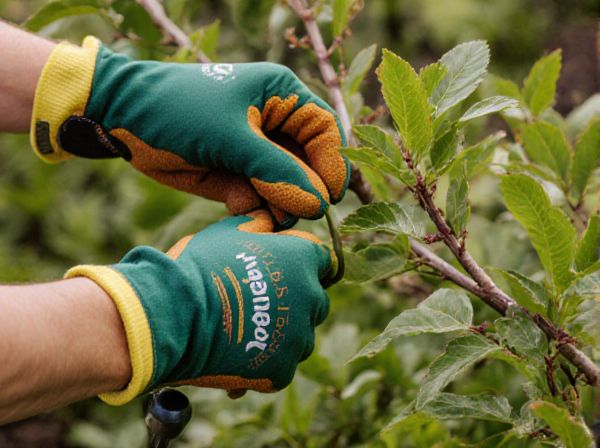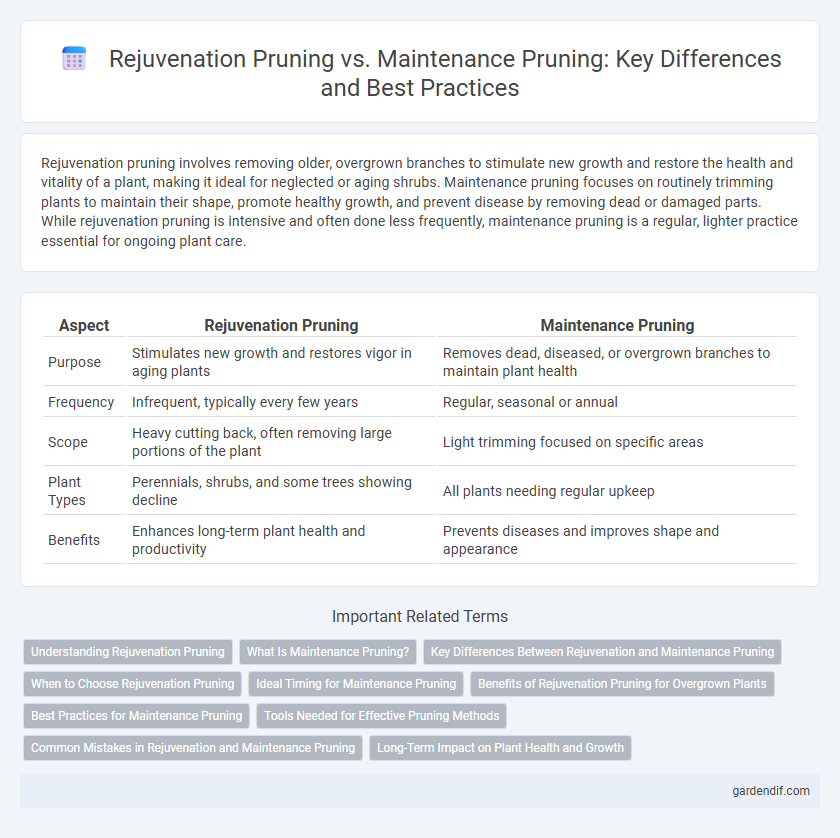
Rejuvenation pruning vs maintenance pruning Illustration
Rejuvenation pruning involves removing older, overgrown branches to stimulate new growth and restore the health and vitality of a plant, making it ideal for neglected or aging shrubs. Maintenance pruning focuses on routinely trimming plants to maintain their shape, promote healthy growth, and prevent disease by removing dead or damaged parts. While rejuvenation pruning is intensive and often done less frequently, maintenance pruning is a regular, lighter practice essential for ongoing plant care.
Table of Comparison
| Aspect | Rejuvenation Pruning | Maintenance Pruning |
|---|---|---|
| Purpose | Stimulates new growth and restores vigor in aging plants | Removes dead, diseased, or overgrown branches to maintain plant health |
| Frequency | Infrequent, typically every few years | Regular, seasonal or annual |
| Scope | Heavy cutting back, often removing large portions of the plant | Light trimming focused on specific areas |
| Plant Types | Perennials, shrubs, and some trees showing decline | All plants needing regular upkeep |
| Benefits | Enhances long-term plant health and productivity | Prevents diseases and improves shape and appearance |
Understanding Rejuvenation Pruning
Rejuvenation pruning involves the selective removal of older, overgrown branches to stimulate new growth and restore the plant's vitality, often used for aging or neglected trees. This technique differs from maintenance pruning, which primarily focuses on routine trimming to shape the plant, remove dead or diseased wood, and maintain health. Understanding rejuvenation pruning is essential for promoting plant longevity and enhancing structural integrity by encouraging vigorous growth and improving airflow.
What Is Maintenance Pruning?
Maintenance pruning involves the regular removal of dead, damaged, or diseased branches to promote tree health and safety. It helps maintain the desired shape and size of the tree, preventing potential hazards such as falling limbs. Unlike rejuvenation pruning, which encourages new growth by cutting back larger portions, maintenance pruning focuses on preserving the tree's existing structure and vitality.
Key Differences Between Rejuvenation and Maintenance Pruning
Rejuvenation pruning involves cutting back mature or overgrown plants significantly to stimulate new growth and restore plant health, whereas maintenance pruning targets the removal of dead, diseased, or crossing branches to maintain the current shape and health of the plant. The key difference lies in the intensity and purpose: rejuvenation pruning is a corrective, restorative process applied less frequently, while maintenance pruning is regular and preventive. Rejuvenation often results in substantial structural changes, while maintenance pruning aims to preserve the plant's existing form and vigor.
When to Choose Rejuvenation Pruning
Rejuvenation pruning is best chosen when a tree or shrub shows signs of decline due to age, neglect, or overgrowth, typically characterized by reduced vigor, sparse foliage, or excessive dead wood. This aggressive pruning technique restores plant health by removing old, unproductive branches, stimulating new growth and improving overall structure. Maintenance pruning, in contrast, is performed regularly to preserve plant shape and remove minor dead or diseased wood without drastically altering the mature form.
Ideal Timing for Maintenance Pruning
Maintenance pruning is ideally performed during late winter or early spring, just before new growth begins, ensuring optimal wound healing and minimizing stress on the plant. This timing helps preserve plant health by removing dead or diseased branches without disrupting active growth cycles. Regular maintenance pruning at the right time enhances plant structure, promotes air circulation, and supports overall vitality.
Benefits of Rejuvenation Pruning for Overgrown Plants
Rejuvenation pruning promotes vigorous new growth and significantly improves the overall health of overgrown plants by removing old, unproductive wood. This method enhances air circulation and light penetration within dense canopies, reducing pest and disease risks. Over time, rejuvenation pruning restores plant shape and vitality, ultimately extending the lifespan of mature or neglected vegetation.
Best Practices for Maintenance Pruning
Maintenance pruning focuses on enhancing tree health and structure by regularly removing dead, diseased, or crossing branches to promote optimal airflow and sunlight penetration. Best practices include using clean, sharp tools to make precise cuts at branch collars, avoiding excessive pruning that can stress the tree, and scheduling pruning during dormant seasons to minimize sap loss and pest infestation. Consistent monitoring and timely pruning help maintain tree vigor and reduce long-term damage compared to rejuvenation pruning, which involves more aggressive cutting to restore neglected or overgrown trees.
Tools Needed for Effective Pruning Methods
Effective rejuvenation pruning requires heavy-duty tools such as loppers, pruning saws, and sometimes chainsaws to remove large, old growth and stimulate new development. Maintenance pruning involves lighter tools like hand pruners, bypass shears, and pole pruners to trim small branches and maintain plant health. Using the correct tools ensures clean cuts, reduces plant stress, and promotes quicker healing in both pruning types.
Common Mistakes in Rejuvenation and Maintenance Pruning
Common mistakes in rejuvenation pruning include removing too much foliage at once, which can stress the plant and hinder recovery, and neglecting proper timing, leading to reduced growth and vigor. Maintenance pruning errors often involve cutting too close to buds, causing dieback, or failing to remove dead or diseased branches, increasing susceptibility to pests and diseases. Understanding these pitfalls ensures healthier plants and more effective pruning outcomes.
Long-Term Impact on Plant Health and Growth
Rejuvenation pruning involves removing older, woody growth, promoting vigorous new shoots that enhance long-term plant health and increase overall productivity. Maintenance pruning targets dead or diseased branches to preserve current plant structure, limiting stress and preventing disease spread without significantly altering growth patterns. Over time, rejuvenation pruning can stimulate renewal and improved vigor, while maintenance pruning sustains plant stability and reduces decline risks.
Rejuvenation pruning vs maintenance pruning Infographic

 gardendif.com
gardendif.com